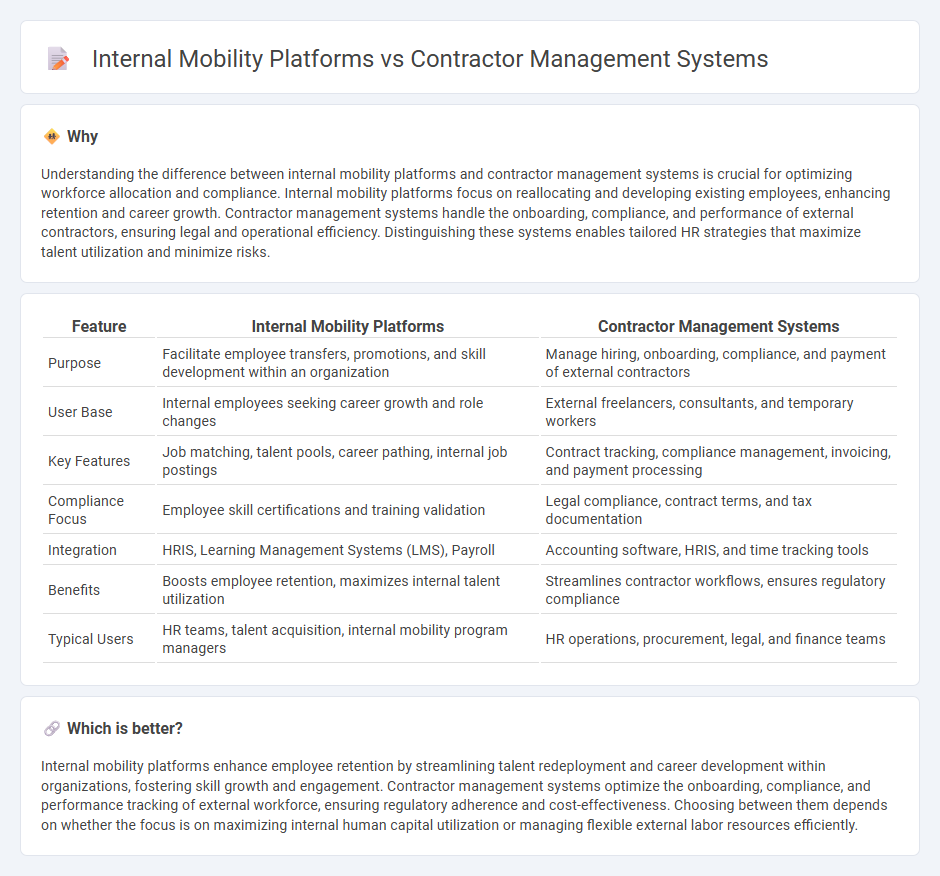
Internal mobility platforms streamline employee career development by matching skills with open roles within the company, enhancing retention and engagement. Contractor management systems focus on overseeing temporary workforce logistics, compliance, and payment processes, ensuring efficient contractor utilization. Explore how integrating these systems can optimize overall workforce management.
Why it is important
Understanding the difference between internal mobility platforms and contractor management systems is crucial for optimizing workforce allocation and compliance. Internal mobility platforms focus on reallocating and developing existing employees, enhancing retention and career growth. Contractor management systems handle the onboarding, compliance, and performance of external contractors, ensuring legal and operational efficiency. Distinguishing these systems enables tailored HR strategies that maximize talent utilization and minimize risks.
Comparison Table
| Feature | Internal Mobility Platforms | Contractor Management Systems |
|---|---|---|
| Purpose | Facilitate employee transfers, promotions, and skill development within an organization | Manage hiring, onboarding, compliance, and payment of external contractors |
| User Base | Internal employees seeking career growth and role changes | External freelancers, consultants, and temporary workers |
| Key Features | Job matching, talent pools, career pathing, internal job postings | Contract tracking, compliance management, invoicing, and payment processing |
| Compliance Focus | Employee skill certifications and training validation | Legal compliance, contract terms, and tax documentation |
| Integration | HRIS, Learning Management Systems (LMS), Payroll | Accounting software, HRIS, and time tracking tools |
| Benefits | Boosts employee retention, maximizes internal talent utilization | Streamlines contractor workflows, ensures regulatory compliance |
| Typical Users | HR teams, talent acquisition, internal mobility program managers | HR operations, procurement, legal, and finance teams |
Which is better?
Internal mobility platforms enhance employee retention by streamlining talent redeployment and career development within organizations, fostering skill growth and engagement. Contractor management systems optimize the onboarding, compliance, and performance tracking of external workforce, ensuring regulatory adherence and cost-effectiveness. Choosing between them depends on whether the focus is on maximizing internal human capital utilization or managing flexible external labor resources efficiently.
Connection
Internal mobility platforms streamline employee career progression by identifying skill gaps and matching talents with new roles, while contractor management systems oversee non-employee workforce compliance, contracts, and performance metrics. Integrating these systems ensures seamless workforce planning, enabling HR to leverage both internal talent pools and external contractors efficiently. This connection enhances organizational agility, talent optimization, and reduces hiring costs by maximizing resource utilization across permanent and contingent workforces.
Key Terms
**Contractor Management Systems:**
Contractor management systems streamline the entire contractor lifecycle by automating onboarding, compliance tracking, and performance monitoring to reduce risks and enhance operational efficiency. These platforms integrate with payroll, safety protocols, and project management tools to ensure real-time oversight and regulatory adherence for external workforce management. Explore the key features and benefits of contractor management systems to optimize your workforce strategy.
Compliance Tracking
Contractor management systems excel in compliance tracking by automating credential verification, safety training documentation, and real-time regulatory updates to minimize risk. Internal mobility platforms ensure compliance through streamlined role-based access controls, employee certification monitoring, and seamless audit trails aligned with company policies. Discover how integrating these platforms can enhance your organization's compliance strategy.
Vendor Onboarding
Contractor management systems streamline vendor onboarding by automating document verification, compliance tracking, and contract management, ensuring faster and more secure integration of external contractors. Internal mobility platforms primarily focus on employee redeployment and career development within the organization, lacking specialized tools for vendor risk assessment and external compliance needed in contractor onboarding. Explore how integrating specialized contractor management systems can enhance your vendor onboarding process.
Source and External Links
Contractor Management Software | Tracking and Scheduling - ADP - This software helps organizations automate onboarding, manage assignments, and pay independent contractors efficiently.
Contractor Management Software System and Training - Veriforce - Veriforce offers a comprehensive solution for managing contractors, including prequalification, compliance, and risk mitigation.
6 Best Contractor Management Software in 2025 - Connecteam - Connecteam provides a list of the best contractor management software, highlighting features for streamlined contractor management processes.
 dowidth.com
dowidth.com